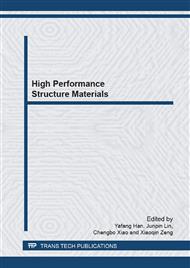[1]
R. Sivakumar, B.L. Mordike, High temperature coatings for gas turbine blades: a review, Surf. Coat. Technol. 37 (1989) 139–160.
DOI: 10.1016/0257-8972(89)90099-6
Google Scholar
[2]
I. Baker, A review of the mechanical properties of B2 compounds, Mater. Sci. Eng. A 192/193 (1995) 1–13.
Google Scholar
[3]
D.B. Miracle, The physics and mechanical properties of NiAl, Acta Metall. Mater. 41 (1993) 649–684.
Google Scholar
[4]
Zhiming Bai, Dongqing Li, Hui Peng, Juan Wang, Hongbo Guo, Shengkai Gong, Suppressing the formation of SRZ in a Ni-based single crystal superalloy by RuNiAl diffusion barrier, Progress in Natural Science: Materials International, 22 (2012).
DOI: 10.1016/j.pnsc.2012.03.007
Google Scholar
[5]
Jing Wu, Hongbo Guo, Musharaf Abbas, Shengkai Gong, Evaluation of plasma sprayed YSZ thermal barrier coatings with the CMAS deposits infiltration using impedance spectroscopy, Progress in Natural Science: Materials International, 22 (2012) 40-47.
DOI: 10.1016/j.pnsc.2011.12.007
Google Scholar
[6]
H.B. Guo, X.Y. Wang, J. Li, S.X. Wang, S.K. Gong, Effects of Dy on cyclic oxidation resistance of NiAl alloy, Trans. Nonferrous Met. Soc. China 19 (5) (2009) 925–930.
DOI: 10.1016/s1003-6326(08)60426-4
Google Scholar
[7]
H.B. Guo, S.X. Wang, X.Y. Wang, S.K. Gong, Cyclic oxidation behaviour of EB-PVD Dy doped β-NiAl coatings at 1100℃, Int. J. Mod. Phys. B 24 (2010) 3143–3148.
DOI: 10.1142/s0217979210066227
Google Scholar
[8]
H.B. Guo, L.D. Sun, H.F. Li, S.K. Gong, High-temperature oxidation behaviour of hafnium modified NiAl bond coat in EB-PVD thermal barrier coating system, Thin Solid Films 516 (2008) 5732–5735.
DOI: 10.1016/j.tsf.2007.07.031
Google Scholar
[9]
Noebe RD, Bowman PR, Nathal MV. Physical and mechanical properties of the B2 compound NiAl, International Materials Reviews 38 (1993) 193-232.
DOI: 10.1179/imr.1993.38.4.193
Google Scholar
[10]
Miracle DB, The physical and mechanical properties of NiAl, Acta Metall. Mater. 41 (1993) 649-684.
Google Scholar
[11]
Rablbauer R, Fischer R, Frommeyer G, Mechanical properties of NiAl-Cr alloys in relation to microstructure and atomic defects, Z. Metallkd 95 (2004) 525-534.
DOI: 10.1515/ijmr-2004-0103
Google Scholar
[12]
Frommeyer G, Fischer R, Deges J, Rablbaur R, Schneider A, APFIM investigations on site occupancies of the ternary alloying elements Cr, Fe, and Re in NiAl, Ultramicroscopy 101 (2004) 139-148.
DOI: 10.1016/j.ultramic.2004.05.006
Google Scholar
[13]
J.T. Guo, K.W. Huai, Q. Gao, W.L. Ren, G.S. Li, Effects of rare earth elements on the microstructure and mechanical properties of NiAl-based eutectic alloy, Intermetallics 15 (2007) 727-733.
DOI: 10.1016/j.intermet.2006.10.020
Google Scholar
[14]
Hongbo Guo, Dongqing Li, Hui Peng, Yongjing Cui, Shengkai Gong. High-temperature oxidation and hot-corrosion behavior of EB-PVD β-NiAlDy coatings, Corrosion Science 53 (2011) 1050–1059.
DOI: 10.1016/j.corsci.2010.11.041
Google Scholar
[15]
Dongqing Li, Hui Peng, Xiaoyu Zhao, Hongbo Guo, Shengkai Gong, Cyclic Oxidation Behavior of β-NiAlDy Alloys Containing Varying Aluminum Content at 1200 °C, Progress in Natural Science: Materials International, in press.
DOI: 10.1016/j.pnsc.2012.06.003
Google Scholar
[16]
George EP, Liu CT, Brittle fracture and grain boundary chemistry of microalloyed NiAl, J Mater Res 5 (1990) 754-762.
DOI: 10.1557/jmr.1990.0754
Google Scholar
[17]
Guo JT, Ordered intermetallic compound NiAl alloy, Beijing: Science Press, (2003).
Google Scholar
[18]
C.L. Briant. On the chemistry of grain boundary segregation and grain boundary fracture. Metall Trans. A 21 (1990) 2339-2354.
DOI: 10.1007/bf02646981
Google Scholar
[19]
Fox A G, Tabbernor M A, The bonding charge density of NiAl, Acta Metal. Mater. 39 (1991) 669-678.
DOI: 10.1016/0956-7151(91)90135-n
Google Scholar
[20]
Hirth J P, Rice J R, On the thermodynamics of adsorption at interfaces as it influence decohesion, Metall Trans. 295 (1980) 139-149.
Google Scholar
[21]
White C L, Padagett R A, Liu C T, Surface and grain boundary segregation in relation to intergranular fracture: Born and sulfur in Ni3Al. Script. Metall. 18 (1984) 1417-1420.
DOI: 10.1016/0036-9748(84)90377-6
Google Scholar
[22]
Ren WL, Guo JT, Li GS, Zhou JY, Effect of Nd on microstructure and mechanical properties of NiAl-based intermetallic alloy, Materials Letters 57 (8) (2003) 1374-1379.
DOI: 10.1016/s0167-577x(02)00990-4
Google Scholar


